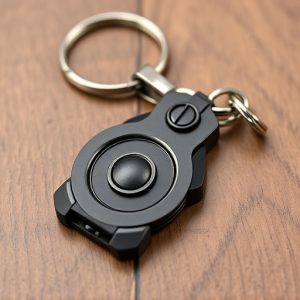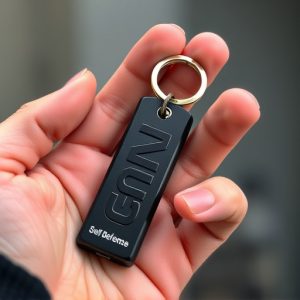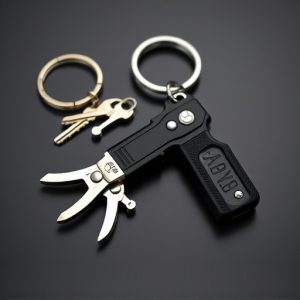Mastering Heart Attack Self-Defense Keychain Design: Grip, Materials, & Tactics
The Heart Attack Self Defense Keychain is a compact, user-friendly tool designed for personal safety…….
The Heart Attack Self Defense Keychain is a compact, user-friendly tool designed for personal safety. By leveraging wrist and arm momentum, users can deliver powerful blows to deter attackers. Choosing durable materials like stainless steel or lightweight aluminum ensures optimal gripping and longevity. Ergonomic design principles ensure comfort and effectiveness in stressful situations, accommodating various hand sizes and distributing weight evenly. Tactical features such as sharp edges and textured surfaces enhance grip and control, making the keychain a convenient yet powerful self-defense tool for everyday carry. Rigorous testing is crucial to refine the design, ensuring durability, comfort, and optimal performance in emergency scenarios.
Unleash your inner defender with the ultimate metal self-defense keychain—a compact yet potent tool designed for sudden, life-saving situations. This article explores the art of crafting a powerful ‘Heart Attack Self-Defense Keychain’ grip. From understanding the core concept to choosing durable materials and incorporating tactical features, we guide you through each step. Learn how ergonomic design principles ensure control and precision. Discover tips for testing and refining your keychain’s grip, making it a reliable companion in any emergency.
- Understanding the Heart Attack Self-Defense Keychain Concept
- Material Selection for Optimal Grip and Durability
- Ergonomic Design Principles for Effective Handling
- Incorporating Tactical Features for Enhanced Defense
- Testing and Refining Your Metal Keychain Grip Design
Understanding the Heart Attack Self-Defense Keychain Concept
The Heart Attack Self-Defense Keychain is a revolutionary concept designed to empower individuals with a simple yet effective tool for personal safety. This compact device is meant to be easily accessible and user-friendly, allowing anyone to defend themselves in unexpected situations. The keychain’s primary function is to enable users to deliver a powerful self-defense blow by leveraging their own wrist and arm momentum, making it an innovative solution for those seeking to deter potential attackers.
Understanding the core principle behind this keychain is crucial. It encourages individuals to be proactive about their safety by providing them with a simple movement that can disrupt an assailant’s hold or strike a vital point, potentially ending an attack quickly. This concept aligns with the growing need for practical self-defense mechanisms, especially in crowded urban areas where one may be at heightened risk of assault.
Material Selection for Optimal Grip and Durability
When crafting a Heart Attack Self Defense Keychain, material selection is paramount for both grip efficiency and longevity. Opt for high-quality metal alloys that combine strength with a comfortable texture. Stainless steel, known for its durability and corrosion resistance, is an excellent choice. It offers a solid grip, ensuring the keychain remains in your hand during critical moments. Alternatively, aluminum alloys provide a lighter option with exceptional strength-to-weight ratio, making it ideal for compact designs.
Consider the balance between material hardness and your intended use. Softer metals may offer better grip but could be more susceptible to scratches and dents. Harder metals provide superior durability against wear and tear but might reduce tactile feedback. Strike a balance by selecting materials that cater to both gripping needs and long-term reliability, ensuring your Heart Attack Self Defense Keychain performs flawlessly in any situation.
Ergonomic Design Principles for Effective Handling
When designing a self-defense keychain like the Heart Attack Keychain, ergonomic principles are paramount to ensure it’s effective and comfortable for users in stressful situations. The grip should be designed to accommodate various hand sizes, promoting a secure and stable hold. Incorporate contours that follow the natural curves of the hand, reducing fatigue during prolonged use. A well-balanced distribution of weight across the keychain is crucial; this ensures control and prevents it from slipping out of the user’s grasp when needed most.
Additionally, consider texturing materials to enhance grip strength without causing discomfort or injury. This can be especially important for those in high-pressure scenarios who may have sweaty palms. The key chain’s shape and size should facilitate a natural, instinctual grip, allowing users to react swiftly and effectively during self-defense situations, making it a reliable tool for personal safety.
Incorporating Tactical Features for Enhanced Defense
When designing a Heart Attack Self Defense Keychain, integrating tactical features can significantly boost its effectiveness as a defense tool. These features often include sharp edges or points designed for penetration, allowing users to defend themselves in close-quarters situations. Incorporating elements like a serrated edge or a distinct point can provide additional leverage and piercing power, making it easier to disable an attacker. The key is to balance the tactical utility with compactness, ensuring the keychain remains convenient for everyday carry while retaining its defensive capabilities.
Moreover, tactical features should enhance the user’s grip and control. Ergonomic designs that fit comfortably in the hand can enable quicker and more precise movements during a defense scenario. Some keychains incorporate textured surfaces or multiple gripping points to improve tactility, allowing users to maintain control even under stress. These thoughtful design choices not only strengthen the keychain’s defensive potential but also ensure it remains a reliable tool for personal safety.
Testing and Refining Your Metal Keychain Grip Design
When refining your Heart Attack Self Defense Keychain grip design, testing is paramount. Craft a prototype and put it through rigorous physical stress tests to gauge its durability and comfort during intense use. Simulate various gripping scenarios, from firm to slippery, to ensure a secure, ergonomic fit for all hands. User feedback is invaluable; consider a small focus group or even a wider beta-testing phase to refine the design further.
Keep iterating based on test results. Adjust metal thickness, grip texture, and overall shape until you achieve an ideal balance of strength, agility, and comfort. Remember, a well-designed keychain grip should enhance your self-defense capabilities without becoming cumbersome or restrictive during emergencies.
The development of an effective Heart Attack Self-Defense Keychain involves a meticulous blend of design, material science, and functionality. By selecting robust metals, adhering to ergonomic principles, and integrating tactical features, you can create a compact yet formidable defense tool. Rigorous testing is crucial to refining the grip design, ensuring it provides secure control during critical situations. Remember, the key to an optimal Heart Attack Self-Defense Keychain lies in its ability to offer both reliable protection and a comfortable, intuitive grip.


